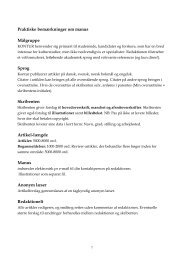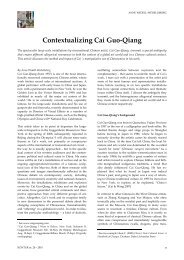Akasegawa Genpei as a Populist Avant-Garde An ... - Kontur
Akasegawa Genpei as a Populist Avant-Garde An ... - Kontur
Akasegawa Genpei as a Populist Avant-Garde An ... - Kontur
Create successful ePaper yourself
Turn your PDF publications into a flip-book with our unique Google optimized e-Paper software.
contributions in the tradition of political manga,<br />
<strong>Ak<strong>as</strong>egawa</strong> w<strong>as</strong> openly political, with his hard graphic<br />
(geki-ga) style enhancing the sense of urgency.<br />
Furthermore, <strong>Ak<strong>as</strong>egawa</strong> went a great distance to<br />
create a coherent series with a deliberate structure of<br />
parody. 14<br />
Fig 4: ”The Flowering Old Man: 1” from The Sakura<br />
Illustrated, No.5 (1970)<br />
Even though each installment is three pages long, it h<strong>as</strong><br />
its own m<strong>as</strong>thead, complete with publication date and<br />
issue number, the fact of weekly publication, the total<br />
page number, the price, and the publisher’s and the<br />
artist’s names (Fig 4). The title panel mimicked that of<br />
Asahi Newspaper, the published of Asahi Journal,<br />
including the cherry flowers in the background down<br />
to the typographical design.<br />
The meaning of sakura is also explained on the<br />
m<strong>as</strong>thead, which reads:<br />
14 For further discussion of The Sakura Illustrated, see Tomii<br />
2002b<br />
KONTUR nr. 20 – 2010<br />
REIKO TOMII<br />
Sakura, or cherry, is the king of flowers and the<br />
national flower.<br />
Sakura is a humble [horse] meat and the<br />
“hecking horse.”<br />
Sakura is an audience who cheers in conspiracy<br />
with the performer.<br />
In other words, by designing this m<strong>as</strong>thead, he<br />
conceptualized The Sakura Illustrated <strong>as</strong> a weekly<br />
magazine in its own right. Most outrageously, in his<br />
conceptual parodic scheme, its printing and<br />
distribution w<strong>as</strong> “subcontracted” to Asahi Newspaper<br />
Company. He even claimed to use Asahi Journal <strong>as</strong> a<br />
tsutsumigami, or “wrapper.”<br />
In his own word, he “hijacked” (nottori) the mainstream<br />
magazine, <strong>as</strong> unambiguously spelled out on every page:<br />
“third-cl<strong>as</strong>s mailing hijacked” (dai-san-shu yūbin nottori),<br />
again mimicking the established custom, “third-cl<strong>as</strong>s<br />
mailing permit,” wherein a publisher is allowed to pay<br />
only the subscription-rate postage. Hijacking w<strong>as</strong> a<br />
topical word at the time, especially with the Japan Red<br />
Army’s highjacking of the airplane Yodo in 1970 still<br />
fresh in memory. (In this incident, nine members of the<br />
militant anti-government group highjacked a Japan<br />
Airline plane which left Haneda for Fukuoka, and<br />
successfully landed in North Korea.) Notably, in art,<br />
“hijacking” is tantamount to “appropriation,” or<br />
borrowing. In devising the design and content of The<br />
Sarkura Illustrated, <strong>Ak<strong>as</strong>egawa</strong> made an extensive use of<br />
appropriation, beginning with the magazine format and<br />
extending to the texts of the wartime elementary-school<br />
readers.<br />
The most notorious example is found in the final and<br />
31st installment, in which he put the phr<strong>as</strong>e “Akai / akai<br />
/ <strong>as</strong>ahi / <strong>as</strong>ahi”—which means, “Red, red [is] the rising<br />
sun”—borrowing from the wartime elementary-school<br />
textbook, nicknamed Asahi dokuhon or Asahi Reader. As<br />
parody, he turned what he borrowed into something<br />
funny, frequently slipping his biting critique of the<br />
original into it. In this c<strong>as</strong>e, the phr<strong>as</strong>e “Red Asahi” is<br />
often construed <strong>as</strong> his mockery of the left-leaning tenet<br />
of the Asahi newspaper. (In retrospect, it could also be<br />
interpreted <strong>as</strong> an allusion to Asahi’s significant role in<br />
the war efforts in the cultural sphere in wartime Japan.)<br />
Asahi duly responded to <strong>Ak<strong>as</strong>egawa</strong>’s mischief by<br />
recalling this issue of Asahi Journal from the newsstand<br />
and bookstores. Naturally, once again, <strong>Ak<strong>as</strong>egawa</strong><br />
became an object of scandal in the m<strong>as</strong>s media,<br />
expanding his portfolio of notoriety.<br />
In brief, The Sakura Illustrated offered <strong>Ak<strong>as</strong>egawa</strong> the<br />
first occ<strong>as</strong>ion to use a mainstream print outlet, while<br />
41




